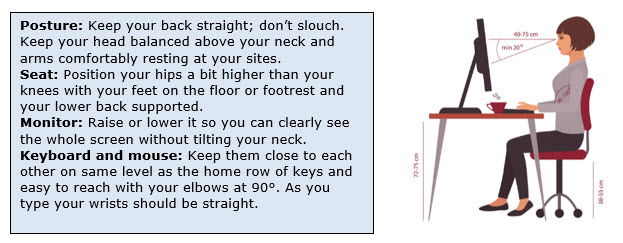Do you feel more tired and less productive when working from home?

With more people working at home, it may be a good time to look at how well you’re handling it. Do you feel tired, less creative or less productive?
Doing a self-ergonomic assessment of your work area is a good first step in finding a fix.
No matter if you’re working at home, in the office or any other setting, awkward posture and repetitive movements can put stress and strain on your body. This can lead to fatigue and not doing your best work. And over time you can get muscle strain, soreness or pain in your neck, back, shoulders or knees. You want to catch and stop these aches early before they become a nuisance or worse.
Making simple ergonomic changes can significantly reduce the stress on your body and create a safer and more comfortable, enjoyable workspace.
Check it out
“Check your environment and body mechanics to ensure an ergonomically friendly workspace that’s set up specifically for you,” says Jennifer Seidl, physical therapist and Executive Director for Rehabilitation Services at Advocate Aurora Health.
Evaluate your workspace for:
- Appropriate chair selection and fitting.
- Organization for efficiency and reduced upper body strain
- Tip: Keep items you use often closer to you
- Improved lighting to reduce eyestrain and neck pain
- Proper keyboard, monitor, mouse and phone placement.
Seidl suggests using this Computer Workstation eTool from the U.S. Department of Labor. For a quick check, follow this guide:

Break it up
Sitting for much of the day is shown to increase the risk for serious health concerns such as diabetes, heart disease and some cancers. Moving around more can help build physical resilience and improve glucose levels and insulin sensitivity, blood pressure, fatigue levels and musculoskeletal discomfort.
“Simple movement or a few minutes of walking can make all the difference in how your body feels and performs while working at a desk,” Seidl says Here’s what she recommends:
- Break up long periods of sitting by incorporating short but frequent periods of stretching or light intensity movement.
- Two to five minutes every 20 to 30 minutes is a good routine to follow.
- Set a timer to remind you to get up and move.
- Add steps to your day:
-
- Take a short walk inside or out, or do some stairs.
- When on the phone or in a virtual meeting, stand up or march in place (off camera, of course).
- Use the bathroom that’s farthest away or on another floor.
Still have musculoskeletal concerns? Take a quiz for your back and neck pain or hip and knee pain to find out what to do next.
Related Posts
Comments
About the Author
Mary Arens, health enews contributor, is a senior content specialist at Advocate Health Care and Aurora Health Care. She has 20+ years of experience in communications plus a degree in microbiology. Outside of work, Mary makes healthy happen with hiking, yoga, gardening and walks with her dog, Chester.

















